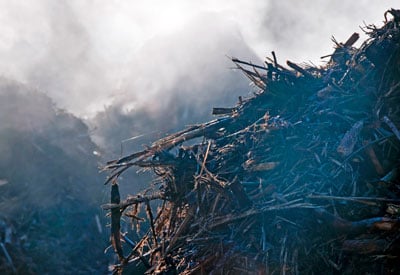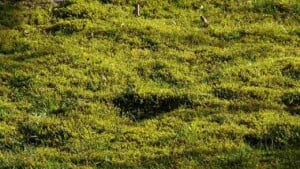It’s a common complaint among us gardeners this time of year, and not just this time of year: We need more compost. When you’re working it into your garden soil, side dressing the plants in your borders and the transplants in your vegetable patch, even spreading it in the lawn to insure a healthy, weed-smothering and pest resistant carpet of green, well, you can go through a lot of compost rather quickly. You don’t want to skimp. But its hard not too when you have so many places in your landscape calling out for rich, organic soil amendment and only a limited amount of production capacity.
All of us organic gardeners are well-versed in the making of compost. But how effective are we when it comes to making compost. I’ve always been something of a “let-it-happen” sort of composter, putting in a minimal amount of work monitoring, turning, and adding to my piles. Patience played a big role in my composting program. I’ve used the two-bin method, a variation of the three-bin method (PDF), because I didn’t have enough room for a third bin. Leaves — my major source of composting material — that were gathered in the fall were usually ready for composting by the next fall with the addition of spring grass clippings and other green nitrogen sources. But often, they would spend another several months in the second bin before they were finished. Coming out of winter, I seldom had enough compost left from the preceding year to meet my spring needs.
At some point, I realized that I needed to be a more efficient composter, that to make more compost I had to have a quicker turnaround time and more composting capacity. That’s when I decided to get a compost tumbler. It didn’t take long to reduce my compost making time from two years to two or so months. While the quantities weren’t great — even my relatively large tumbler turned out something less than roughly 10 cubic feet of compost a couple, three times a year — the fact that I was turning out compost more frequently served to increase compost productivity.

FREE SHIPPING!
Compact (88 gal.)
The perfect size for families that generate 2-3 bags of material monthly.
Learn moreThere’s no reason to think that making the best compost is out of reach. At Planet Natural we supply everything you need: bins, tumblers and activators to get your pile cooking, plus worm farms for kitchen scraps. We know what makes gardens grow.
There was another advantage of using a tumbler. I began to pay more attention to the details of composting. To work at peak efficiency, a compost tumbler requires the perfect ratio of green and brown, nitrogen and carbon ingredients. It also requires a Goldilocks quota of moisture — not too much, not too little, but just right — and it requires frequent turning, say once a week, to keep the ingredients well-mixed and cooking. This made me start paying more attention to my compost heaps. Was I maintaining a good balance of green and brown materials? Did the piles contain enough moisture? Was I turning them as they reached peak temperature, roughly every three to five weeks during the growing season, to ensure adequate oxygen and material distribution?
Maximizing compost production requires providing ideal conditions and an adequate supply of green and brown materials. Here are some things we’ve learned from experience and have gathered from other sources that help us produce as much compost as we possibly can. No doubt, our list is incomplete and overlooks some suggestions that can help immensely. That’s where you come in. Let us know how you maximize your compost production.
- Make your compost heaps large enough. The bigger the bin, the more heat producing area you’ll have. Larger piles also retain moisture better. A four-x-four foot area is a good size; smaller works but this is one case where bigger is definitely better. Of course, this creates another problem . . . can you gather enough raw material to fill a large compost heap?
- Be creative when sourcing materials for your heaps. You’ll need much more brown, carbon material than green nitrogen material (most compost guides recommend a ration of as much as 30-to-one). Shredded brown cardboard makes a great addition (we’re not so fond of composting white paper or newspaper because of the bleach and other undesirable material they might harbor; unprinted newsprint paper is fine). Securing old bales of straw is a quick way to add brown material (hay contains weed seeds and most compost piles don’t heat up enough to prevent them from germinating once the compost is spread in your garden). Shredded sticks and pruning debris are also good as long as they are shredded. They also help create air spaces (see “aeration,” below)in the pile which speeds the decomposition process (composting require oxygen).
- Consider using stable wastes, coop cleanings and bedding material in your compost. The best compost I ever made was when I had a ready supply of urine-rich, manure-laced straw bedding from goat pens. If you’re lucky enough to have a source for stable straw, then you’re a blessed composter indeed. You should probably add more brown material to your heap to balance the nitrogen-rich manures in your stable straw, but the cleanings themselves, depending on how many animals you have and how much time has passed between cleanings, can be pretty close to balanced. Some caveats: horse manure will carry weed seeds that can survive the composting process; “hot” manures, like chicken and hog droppings, will need extra composting time so as not to burn your garden plants with too much nitrogen. Goat manure, mixed with straw, is perfect, neither too hot or loaded with viable weed seed.
- Keep your pile moist. Nothing slows down the creation of compost than a dry pile. Water the layers of ingredients as you construct the pile and keep it moist (but not too) between turnings.
- Aerate. Providing shredded sticks and other debris that creates air spaces in your pile will speed the process along. Crumpled paper and cardboard can also help. This is one of the reasons you turn your pile: to inject more air and help create spaces for it.
- Use a compost thermometer to monitor the heat of your pile. Monitoring the temperature will reveal when you’re doing everything right. It will also let you know if you’ve reached temperature hot enough to destroy weed seed (good luck!).
- Don’t be afraid to harvest compost early. Not every ingredient in your pile will decompose at the same rate. Shredded sticks and other dried material like wood chips and corn stalks will help your compost develop quickly by aiding aeration but may not decompose completely themselves. Don’t wait for them to finish. Use a screen to separate compost that’s crumbly and ready for the garden from these other materials. Then throw them back into the next heap.
Looking back over this list suggest one thought: all the suggestions require more attention and more work. Maybe you don’t need more compost. Lucky you. But if you do, remember: any effort applied to making compost more quickly and efficiently is worth it.











